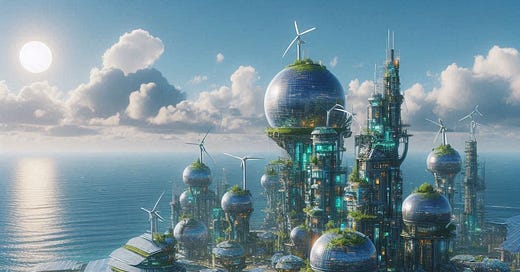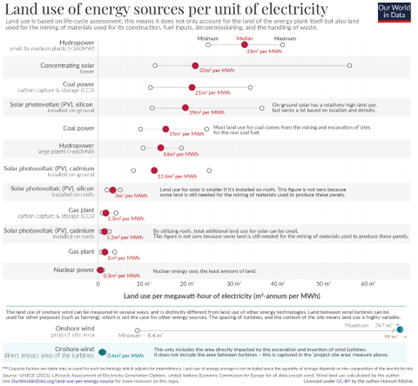Why Nuclear?
Nuclear fission has a proven track record extending to the post-WW2 period. In ensuring robust foundational science, prosperity, and flourishing, we as a species should be able to harness as many energy sources as possible to provide a prosperous future. This view of the world is not naïve but completely in line with game theory. We have survived 80 years of relative peace through mutually assured nuclear destruction. The synonymous conflation of nuclear energy with war has prevented a robust transition to a green/clean technology. This transition could help bring people out of poverty, bring about a meaningful impact towards decarbonization, and uplift scores of people.
Offering each other a world of abundance is an attractive win/win. The tectonic plates of geopolitics are shifting. Leverage can be used with compassion, mutual regard, humanity, or cruelty. I prefer that sanity prevails. The difficulty is walking the fine line between consensus and coercion. It’s a dangerous thing to play the game as people so often become the ideas they find objectionable. This is an argument for a diverse energy future and why that matters, particularly regarding nuclear energy.
Jack Devanney at the Gordian knot has a very informative substack and I highly recommend it. His writing is a great resource to be referenced.
The Case for Nuclear Reactors
Nuclear plants used to take considerable amounts of time and money to complete with ever increasing costs. Small modular nuclear reactors (SMRs) seek to disrupt this paradigm. This resets a trajectory that should have occurred in the 70’s. I only say this because energy is prosperity and the global population has doubled since 1974. The US has added about 130 million people without the appropriate energy infrastructure investments.
Nuclear has already been embraced by the US, China, France, Russia, Japan, Korea, India, and Canada. The world needs more exposure to nuclear technology and it should be used as a tool to round out our energy transition.
“667 reactors have been built worldwide since the first was built in 1954 in Obninsk, Russia, though currently, there are only 436 in operation, 93 of which are in the U.S. As of May 2023, 59 reactors were under construction, including 1 in the U.S. and 23 in China.”
Cost Burden
Levelized cost of energy (LCOE) includes the lifetime costs of building, operating, maintaining, and fueling a power plant. “Roughly one-third of the costs are “indirect”, the costs of the building process: engineering services, construction management, administrative overhead, etc. For the direct costs (the cost of materials, equipment, and on-site labor), the reactor, the turbine equipment, and the plant structures each make up 15-20% of overall costs, with the balance made up by additional plant systems. Also, note that the plant’s engineering design cost nearly as much as the reactor itself.”
A 1980 study found that increased regulation between the late 1960s and mid-1970s was responsible for a 176% increase in plant cost, and increased labor requirements by 137%:
Again, the Gordian Knot corroborates many of these ideas.
“Several large nuclear power plants were completed in the early 1970s at a typical cost of $170 million, whereas plants of the same size completed in 1983 cost an average of $1.7 billion, a 10-fold increase. Some plants completed in the late 1980s have cost as much as $5 billion, 30 times what they cost 15 years earlier. Inflation, of course, has played a role, but the consumer price index increased only by a factor of 2.2 between 1973 and 1983, and by just 18% from 1983 to 1988. “
When discussing apples-to-apples comparison of energy costs, externalities (in the form of pollution, labor, human rights practices, remediation), subsidies, tax credits, and unnecessary regulatory burden should be used in the calculation. I would argue that land/water use and any increase in population density should also be factored into the equation. That presently isn’t the case as far as I can tell. I also have difficulty finding the combined cost of storage which is a required component for Solar/Wind. This would offer a more complete calculation of energy costs & LCOE.
This table is one of the most informative I’ve been able to find. Of particular interest would be cost with/without tax credits. You can see how as technolgies become more mature, effiency and design constraints dwindle, calculation of power per density of land and water use round out the picture of future energy needs.
Land and water use vs LCOE
Arguably in a world that has a limited amount of fresh water resources and ideal zones for comfortable human habitation, land and water use should be a factor in power considerations. Here’s a peak at how much land/water is used per type of energy consumption as a first approximation.

The ‘Our world in Data’ visualization doesn’t do the the graph enough justice. You should spend some time exploring it. It’s a very good reference.
Various Incarnations of Nuclear
“The Generation IV International Forum (GIF) was initiated by the US Department of Energy in 2000 and formally chartered in mid-2001. It is an international collective representing governments of 13 countries where nuclear energy is significant now and also seen as vital for the future. Most are committed to joint development of the next generation of nuclear technology. The original charter members of GIF are Argentina, Brazil, Canada, France, Japan, South Korea, South Africa, the UK and the USA. They have been joined by Switzerland, China, Russia, Australia, and, through the Euratom research and training program, the European Union. The purpose of GIF is to share R&D rather than build reactors.”
There is a lot of information on the various generations of nuclear reactors.
SMRs
My interest in SMRs comes from a decentralized approach to energy grids that can satisfy the needs of small communities, build resilience in the grid, and disrupt energy monopolies. You are effectively taking a large plant, scaling it down, manufacturing in quanitity in a more mass produced fashion.
I found this on Flikr – it’s the closest I’ve come to my visualization of how a small city energy consumption needs works. I often think in pictures and finding the time to coordinate a person’s thoughts to a visual can be very time consuming. This is when the internet is a wonderful thing. Thank you to Zachary Veach.This is brilliant!
SMRs, Decarbonization & Abundance
My argument for decarbonization is shared human flourishing. I believe in anthropogenic climate change. Mitigation and adaptation in societial needs are pressing. Land/water use is the most immediate issue in a world that uses half its livable land mass to feed itself. Transmission lines can take anywhere between 7-15 years to build. If we are truly interested in a decarbonized future, SMRs make complete sense. More importantly, embracing nuclear should be the goal. The first step in that goal is not a new Cold War with anyone. As a species, we are in constant negotation with each other. The UN is a vehicle for this communication and a Nuclear Non-Proliferation Treaty should be renegotiated. Learn from the mistakes of the past.
The benefits of SMRs are obvious– a decarbonized, decentralized grid, built with strict standards, employing skilled workers, manufacturable in standardized quantities, transportable by truck or train, and they are dual purpose. While providing electricity SMR’s can provide heat as well as green hydrogen. Here’s a peek at various players in the field, the physics behind what’s happening and the competing designs.
Decarbonization is the goal to bring a prosperous future for everyone. I do not believe that solely solar/wind and batteries will get us to a reduction in energy poverty. This isn’t advocacy solely for nuclear fission. It’s a tool in a toolkit that provides flexibility, resilience, and options. Battery adoption has only been on the uptick since 2019 or so. Many green environmentalists didn’t even admit to the need for batteries to stabilize the intermittency of wind/solar. There are many factors when considering what a state or nation needs. Local resources, geography, population, minerals, supply chains, capital and regulatory requirements, safety, resilience, and national security. It’s a mix that creates robustness, foundational science, and puts humanity on the path to safety. By being able to manipulate our environment in harmonious ways, we are recognizing that we are here for a brief time and our lives and communities can be incredibly fragile. Let’s find awe and wonder in that as well as a healthy respect for the home that houses us. There are many, many reasons for future generations to be hopeful.












This is very aligned with a similar investigation I did a few months / years back on SMRs for the Department of Defense. Our two analyses go hand in hand.
https://www.polymathicbeing.com/p/nuclear-meltdown
You shouldn't mix SMRs with micro reactors. Mainstream nuclear is around 1-2.5 GW. SMRs are around 300-500 MW. SMRs are still large construction projects.
Micro reactors ala Radiant are aiming for 1-6 MW (about the size of large diesel generators). These are the ones that can be mass manufacturable and transportable via shipping containers. These will the decentralised nuclear future - not SMRs.
I personally don't support large nuclear including SMRs because nuclear is not possible without big government or corporatism. Nuclear takes like 5-9 years to build and 30 years to pay off your construction costs. Even if you take away cost overrun risk no bank in the world is going to finance that without government support.
In contrast solar and batteries are a libertarian's wet dream. I might have to support some government subsidies in the short run but I'm investing in the freedom of future generations.